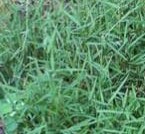 Nimblewill is a perennial grass native to eastern North America where it grows in moist partially shaded areas such as open woodland. It does particularly well in disturbed areas and is found in lawns, gardens, orchards, and nurseries. A warm weather grass, it grows well in the summer but turns brown in early fall so is considered undesirable as a lawn grass. In warm climates nimblewill can become aggressive in lawns especially is moist, shady areas with infertile soil. It is often mistaken for Bermuda grass or creeping bentgrass.
Nimblewill is a perennial grass native to eastern North America where it grows in moist partially shaded areas such as open woodland. It does particularly well in disturbed areas and is found in lawns, gardens, orchards, and nurseries. A warm weather grass, it grows well in the summer but turns brown in early fall so is considered undesirable as a lawn grass. In warm climates nimblewill can become aggressive in lawns especially is moist, shady areas with infertile soil. It is often mistaken for Bermuda grass or creeping bentgrass.
Description:
Branching stems form roots at the nodes and create dense mat ¾-1 ½ feet tall. The leaves are green to grayish green, hairless, and ¾ -3 inches long. The seed heads are narrow panicles of spikelets between two and eight inches long, and may be grayish-green, purplish green, or silvery green. Seeds are produced from mid-summer to early fall and can cling to the hooves of animals and feet of people. The root system is fibrous but the plant can spread by stolons that root at the nodes as they go across the soil surface.
Control:
Hand pulling and low level lawn mowing are the most effective methods of controlling light infestations. Plants can be raked out of the lawn when brown in the fall and replaced by desirable turf grass that can compete favorable with the nimblewill. Although the root system is shallow, however, any little piece of root that is left in the soil will grow into a new plant. The use of herbicides is limited; a selective herbicide with the active ingredient mesotrione is effective but difficult to find. The alternative is a non-selective herbicide that will kill most plants that it comes in contact with so is a last resort.